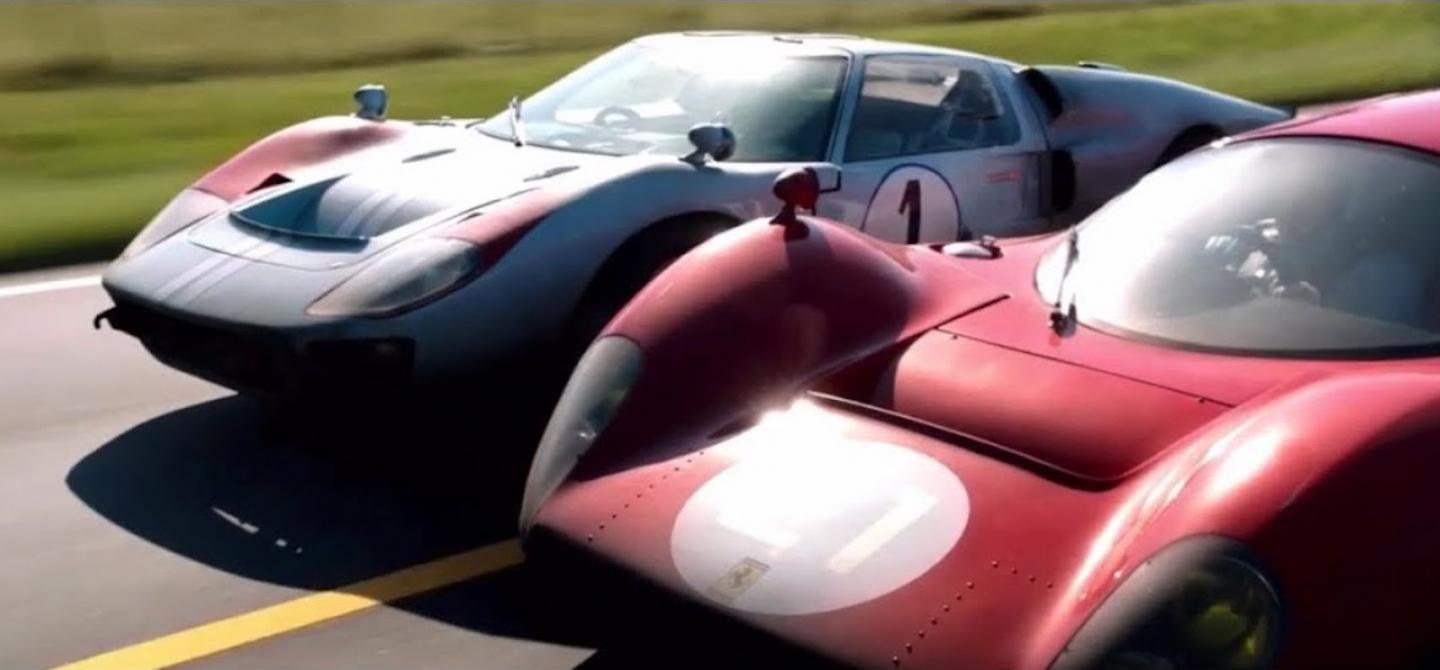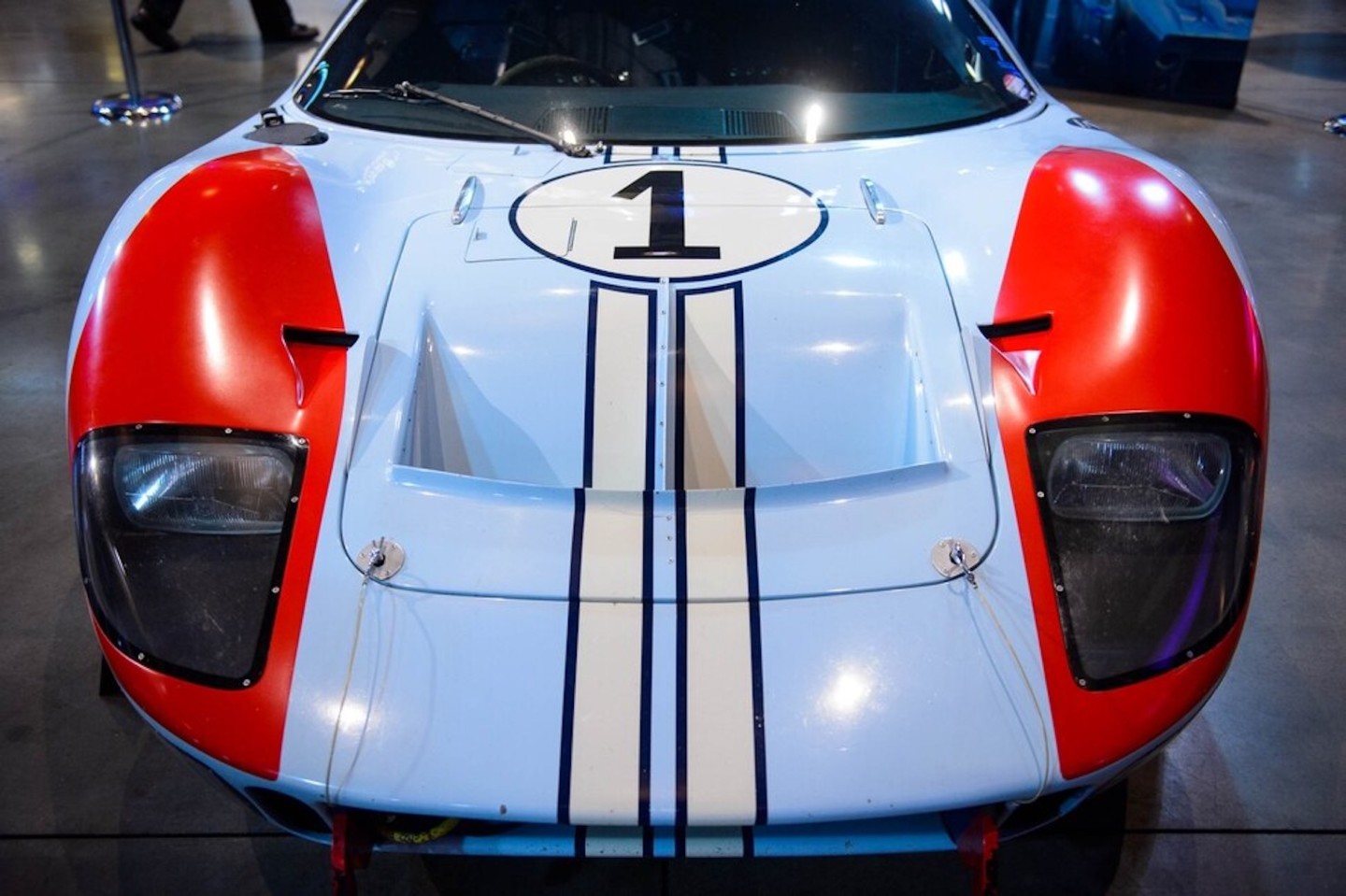Looking at previous installments of this column, it’s obvious my favorite car movies are ones of an art-house nature rather than straight-up actioners. Films such as Two-Lane Blacktop, Vanishing Point, and Drive are my highest ranked in the past. The same is true for my racing movies, with Le Mans, Rush, and Grand Prix being my three favorites.
Recently, a racing movie was released that combined action with high-art qualities. Not only did it become the darling of audiences, but it managed to garner an Academy Award Nomination for Best Picture, and make a boat-load of cash in the process.
Of course, the movie I am referring to is Ford v Ferrari, and it’s the subject of this month’s edition of “Rob’s Car Movie Review.”

The Ford v Ferrari original one-sheet theatrical movie poster. (Image courtesy of Twentieth Century Fox Film Corporation.)
Ford v Ferrari was produced by Chernin Entertainment and released in the United States in 2019 by Twentieth Century Fox. Throughout its development, the film was considered a top project around town. As such, it ended up attracting an illustrious cast and above-the-line crew.
James Mangold, all-star helmer of such films as Walk the Line, Copland, Girl Interrupted, and The Wolverine, directed. The film was based on a script by award-winning brothers John-Henry and Jez Butterworth.
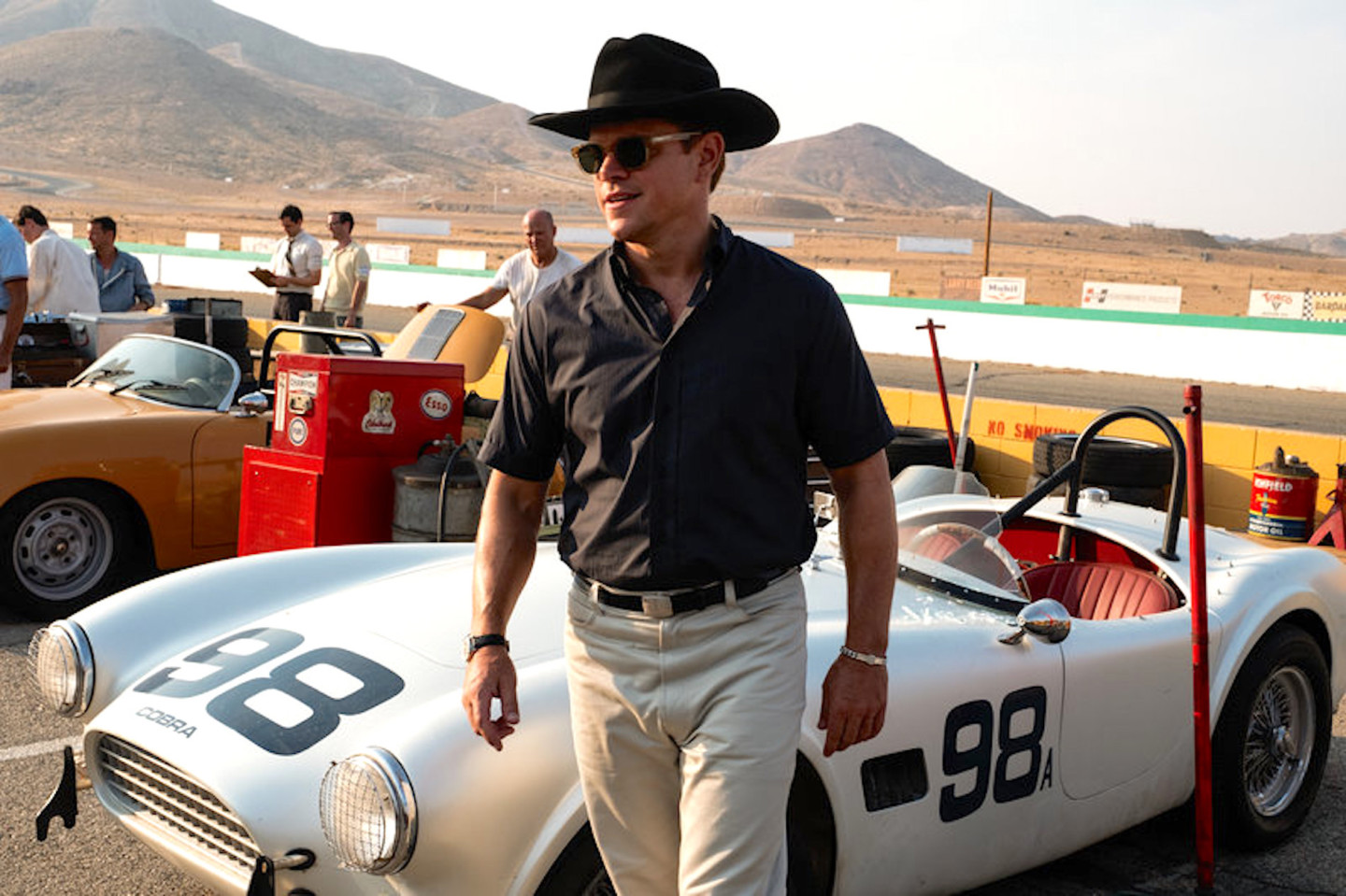
Matt Damon stars as legendary car builder and retired race car driver Carroll Shelby. (Photo courtesy of Twentieth Century Fox Film Corporation.)
The cast is equally A-list, featuring Academy Award winners Matt Damon and Christian Bale, along with Josh Lucas and John Berthal.

Christian Bale, as British racer Ken Miles, wins an SCCA race early in the film. (Photo courtesy of Twentieth Century Fox Film Corporation.)
Ford v Ferrari tells the true-life story of the Ford Motor Company’s effort to beat Ferrari at the 1966 running of the 24 Hours of Le Mans. Having been duped by Enzo Ferrari in an attempted bailout of the Ferrari company, Henry Ford vows revenge. He sends Lee Iacocca (Berthal), one of his top executives, to subcontract the legendary race driver and sports car manufacturer, Carroll Shelby (Damon), to build a car to beat Ferrari at the world’s most grueling race.
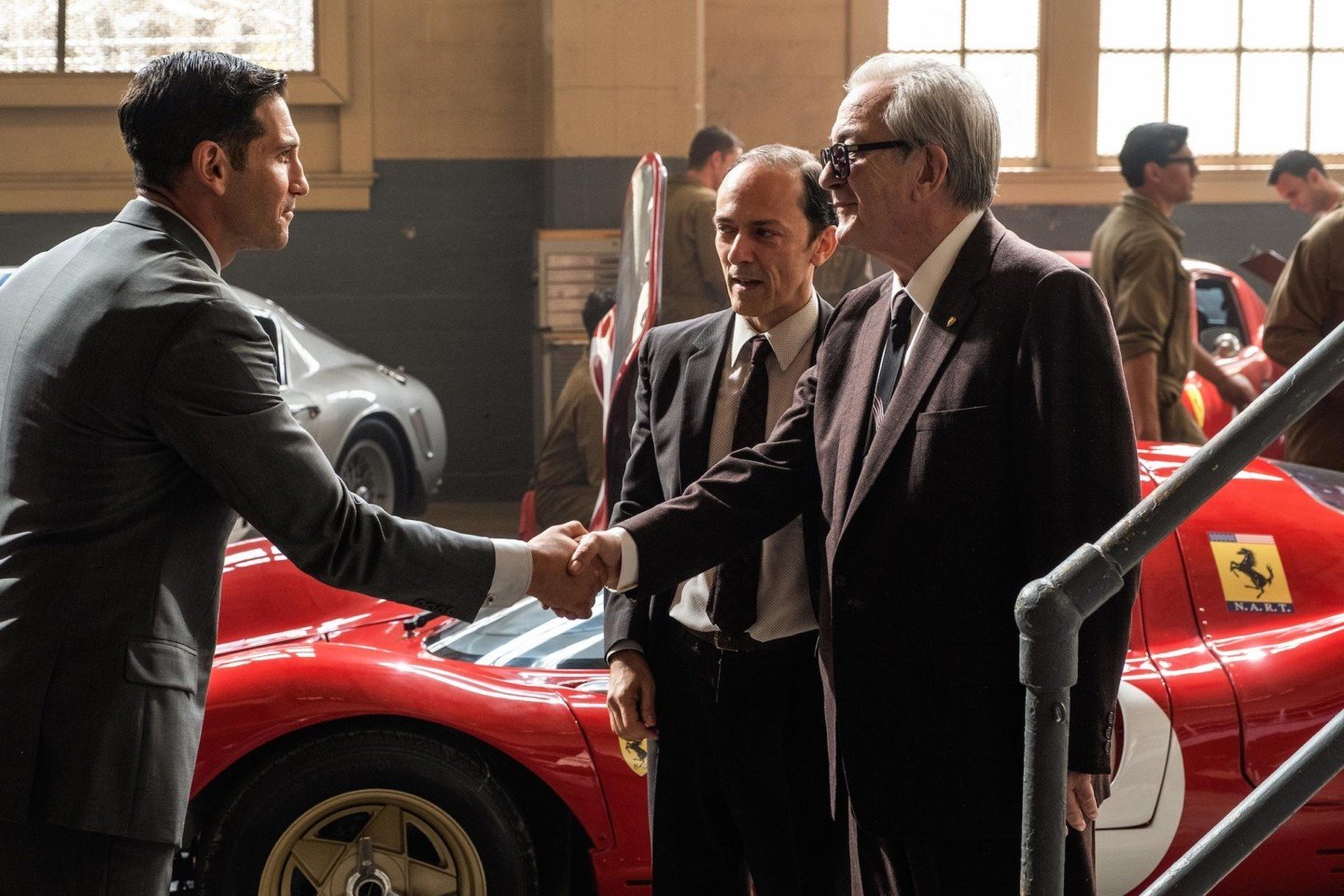
The seminal moment when Henry Ford II’s emissary, Lee Iacocca (John Berthal), meets and is subsequently duped by Enzo Ferrari (Remo Girone.) (Photo courtesy of Twentieth Century Fox Film Corporation.)
Enlisting the help of seasoned race driver Ken Miles (Bale), Shelby crafts the GT40, but the sailing isn’t smooth – many technical challenges deal Shelby and his crew failure after failure. In one test session, Miles is nearly immolated after brake failure and a subsequent high-speed shunt. To compound their problems, Ford executive Leo Beebe (Josh Lucas) has personal issues with Miles and connives to have him dropped from the Ford race team.

Shelby gives his boss, Henry Ford II (Tracy Letts), a spin in Ford’s Le Mans challenger. (Photo courtesy of Twentieth Century Fox Film Corporation.)
Whether Shelby can perfect the GT40 in time, keep Miles on his team, and win Le Mans for Ford hangs in the balance.
Ford v Ferrari is a superlatively well-crafted film. Most startling is its mega-budget production design. It effortlessly transports us back to the mid-’60s with all the period architecture, signage, and wardrobe that pop culture junkies could ask for.
The film’s script is a thing of beauty, too. It yields a sprawling scope, superb dialogue, and excellent character development. The directing is flawless, with a keen eye for tone and the need for occasional humor during the proceedings. And the performances? Beyond excellent, especially from Bale, who owns Ken Miles’ every quirk and peccadillo.
The technical facets of the film are excellent, with Phedon Papamichael’s stunning cinematography. The Academy Award-winning film and sound editing exist as notable works of beauty that keep the film moving and engaging. The automotive action and racing sequences are par with the best ever filmed.

Specially constructed camera cars were used to capture the racing action, which is top flight. (Photo courtesy of The Daily Drive.)
Having said all that, the film is not without some flaws. There are plenty of liberties taken in terms of the timeline and characters involved in the actual events. Ferrari’s legendary driver and noted gentleman, Lorenzo Bandini, is unfortunately depicted as a mute, scowling, olive-skinned villain. Also, several people that were integral to the actual story were deleted or were combined in the cinematic one. Not an uncommon phenomenon in filmmaking, but one I noted, owing to my familiarity with the real-life events.
Some simplifications grated on me. They were made simply for the sake of non-racing fans to ensure they understand the more technical aspects of the sport. It’s also clear there are many examples of CGI being used to replace practical stunts in many sequences. But that’s to be expected in this day and age. And can Hollywood (please, please, please) dispense, once and for all, with drivers turning to glare at each other during a battle at 200-plus miles-per-hour? It’s positively corny and idiotic, as taking your eyes off the road for a fraction of a second at that speed would, in reality, end in certain doom.
All in all, though, this is one hell of a well-made movie.

It was necessary to substitute modern replicas for real priceless cars because many in the film take a thrashing. The reproductions were supplied by Irvine-based, Shelby Legendary Cars and its parent company, Superformance. (Photo courtesy of Superperformance.)
What’s more, the cars in the film are, in a word, insane, and too numerous to highlight them all here. Many of the cars too valuable to be driven in the movie were instead modern replicas sourced from Irvine-based Shelby Legendary Cars and its parent company, Superformance.
Many real vehicles were used for “beauty shots” and close-ups. In the film, it’s nearly impossible to tell which are real and which aren’t, so I’ll dispense with the idea of trying to. Instead, I’ll just focus on what types of cars make an appearance.
Beginning with the non-racing vehicles, Carroll Shelby’s ride through most of the film is a Shelby Cobra 289 in royal blue with a black interior. The car features the slimmer, less bulbous bodywork of the earlier cars, as opposed to the wild, flared features of the later 427-cubic-inch models. The Cobra is often given quite a drubbing by Matt Damon or his stunt driver, with lots of burnouts and ludicrous maneuvers performed.

Late in the film, Shelby is seen driving a bright red 1956 Porsche Type 356A. (Photo courtesy of Twentieth Century Fox Film Corporation.)
Later in the film, Shelby is seen driving a gorgeous, bright red 1956 Porsche Type 356A. The car looks great with modified bodywork and bumpers. The closing shot of the film depicts Shelby racing away into the sunset down the trafficked streets of Los Angeles in the car.
Also featured are a pair of 1965 Mustangs during a scene depicting the launch celebration of the Mustang – one a black coupe, the other a white convertible.

A pair of stunning ’65 Mustangs appear in the Mustang reveal scene. (Photo courtesy of Twentieth Century Fox Film Corporation.)
At the beginning of the movie, Ken Miles is seen working on a gorgeous black 1959 MG A 1600 Mk I Roadster, replete with all the chrome and wire wheels you’d expect. Other street cars seen include a smattering of Corvette C1s, a glorious 1961 Ferrari 250 GT SWB SEFAC, a Ferrari 275 GTB, a ’57 Ferrari 625/250 Testa Rossa, and a 1963 Jaguar XK-E. The Jag is ironic, as it was the car Enzo Ferrari privately grumbled was the most beautiful car ever made.

The Shelby Racing factory houses an amazing collection of vintage racers and street cars. (Photo courtesy of Twentieth Century Fox Film Corporation.)
The film goes all-out with its race cars. In the warehouse Shelby uses to house his racing operations, we see a collection of some of the finest – and today, most valuable – Shelby cars. There are Cobras of every year, shape, and displacement; Shelby GT350s, and my absolute favorite, the sublime Shelby Daytonas.

The film’s depiction of Ferrari’s Gestione Sportiva racing factory also houses some serious cars. (Photo courtesy of Twentieth Century Fox Film Corporation.)
Equally stunning are the four-wheeled beasts seen in the Ferrari factory in Maranello. They include Type 156 Formula 1 cars, Testarossas, 1962 GTOs (now amongst the most expensive cars in the world), and others.
On the track, the film gives us some of the most legendary GT, sports, and prototype cars ever raced. Aston Martin DBR1/300s, Porsche Type 356, 904/4, 904/6, and 906s, Ford J cars, Ferrari 330 P3 Spyders, Ferrari 365 P2s, Ferrari 275 GTB/Cs, Alpine A210, Austin-Healey Sprites, Matra M620s, Chaparral 2Ds, Bizzarrini P538 Super Americas, and probably a dozen others I missed.
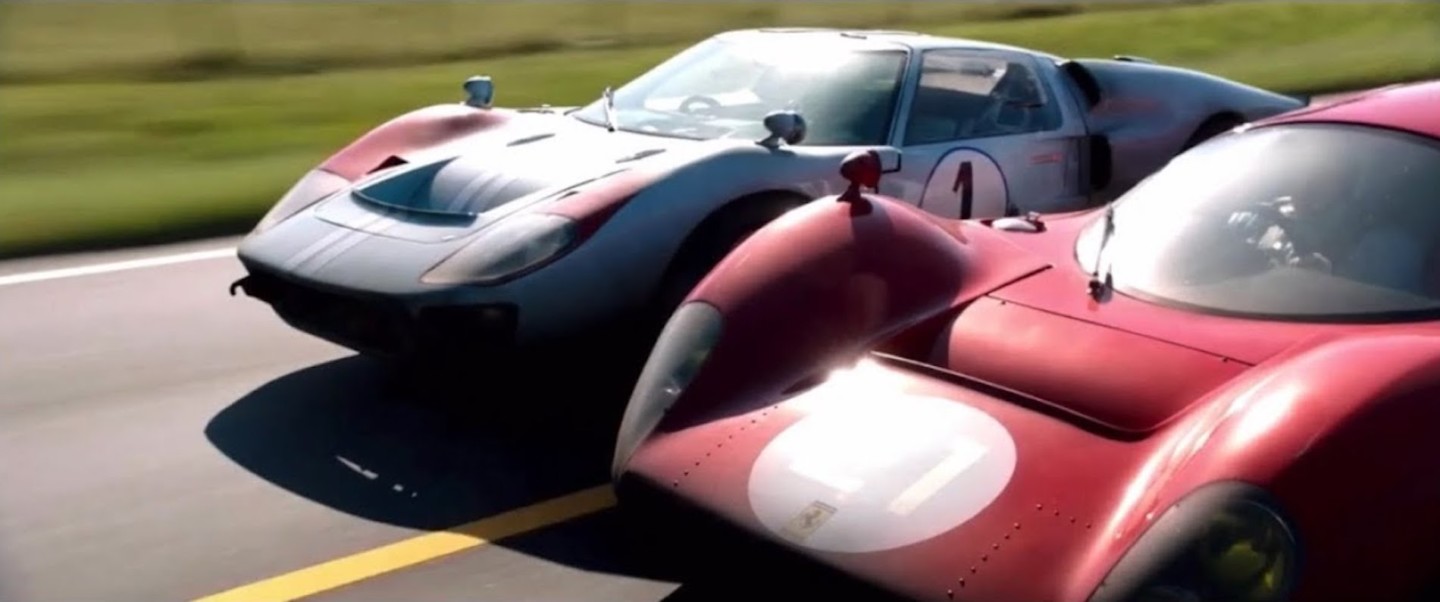
The stars of the show – the Ford GT40 and 1966 Ferrari 330 P3. (Photo courtesy of Twentieth Century Fox Film Corporation.)
But the automotive stars of the show are just two: the 1966 Ferrari 330 P3, and of course, the Ford GT40, seen in MK I and MK II configurations. These were both the contenders for the big prize – Le Mans. They are sleek, sinuous, and fabled beasts lovingly photographed and depicted in a pitched battle in the last act of the film.
Ford v Ferrari is that rare Holy Grail for me: a good old-fashioned car movie that also stands as a superlative piece of cinema. It doesn’t hold the same place in my heart as Le Mans –no one can replace Steve McQueen. Nonetheless, it is one of the best racing movies ever made and is destined to be a classic of the genre. I give Ford v Ferrari eight out of ten pistons.


